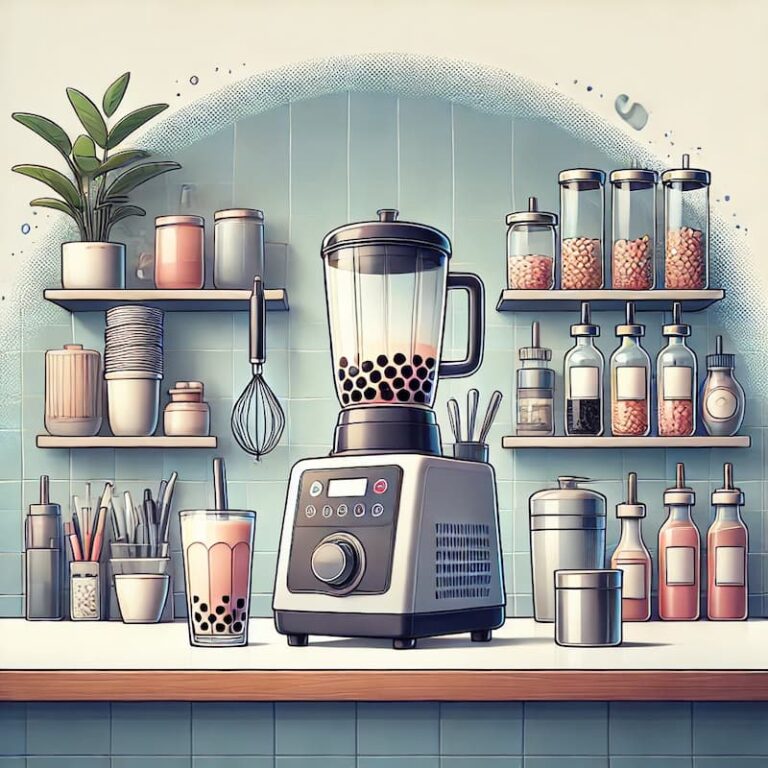

Learn How to Maintain Your Boba Tea Blender with simple cleaning and care tips to ensure consistent performance and longevity.
A well-maintained blender is the heart of any boba tea shop, ensuring smooth, creamy beverages that customers love. By taking the time to clean and care for your equipment, you can avoid costly repairs, maintain hygiene, and deliver consistent drink quality every day.
A clean and well-maintained blender is essential for both the quality of your drinks and the health of your business. Neglecting maintenance can lead to wear, damage, and even contamination, which impacts the customer experience and your bottom line.
Regular maintenance ensures that your blender operates at peak performance, blending ingredients smoothly and evenly. Worn-out blades or a malfunctioning motor can leave chunks in your beverages, which is far from the creamy, consistent texture customers expect.
Addressing minor maintenance needs early can prevent bigger problems. For instance, replacing a dull blade is far cheaper than fixing a burned-out motor caused by overworking the machine.
A dirty blender can harbor bacteria and mold, putting your customers’ health at risk. Regular cleaning and inspections help you comply with health regulations and avoid potential fines or reputational damage.
Daily cleaning is a non-negotiable step to ensure your blender is ready for the next day of service. A simple, consistent routine can extend the life of your equipment and keep it in optimal condition.
Begin by unplugging the blender and carefully disassembling it. Remove the jar, blade assembly, and any seals or gaskets. This allows you to clean each component individually and ensures no hidden food residue is left behind.
Wash the jar, blades, and seals with warm water and a food-safe cleaning detergent. Avoid harsh chemicals that might damage the parts or leave a residue that could affect the taste of your drinks.
After washing, dry all components thoroughly with a clean towel or allow them to air-dry completely. Moisture can promote mold growth, especially in crevices like the blade assembly or under the jar lid.
In addition to daily cleaning, a weekly deep clean removes stubborn buildup and ensures long-term efficiency. This is also an opportunity to inspect your blender for potential wear and tear.
Use a gentle brush or sponge to scrub away any stuck-on food particles or syrup residue from the blender jar and blade assembly. For hard-to-remove buildup, soak the parts in warm, soapy water for 15–20 minutes.
Check the blades for dullness, chips, or warping. Examine the seals and gaskets for cracks or brittleness. Damaged components should be replaced immediately to avoid leaks or poor performance.
Dust and liquid spills can accumulate under the blender’s base, causing overheating or electrical issues. Use a dry cloth or compressed air to clean the motor area and ensure proper ventilation.
The blender blades are critical for achieving the perfect texture in your drinks. Proper blade care keeps your blender efficient and ensures every boba tea is blended to perfection.
A dull blade struggles to blend efficiently, leaving chunks in your drinks and overworking the motor. If blending times are increasing or the texture is uneven, it’s time to inspect the blades.
Always unplug the blender before handling the blades. Use a wrench or the provided tool to carefully remove the blade assembly. When replacing, ensure the new blade is securely tightened to avoid leaks or improper blending.
Sharpen blades periodically if your model allows it, or replace them according to the manufacturer’s recommendations. Regularly lubricate the blade assembly (if applicable) to ensure smooth operation.
Even with regular maintenance, occasional issues can arise. Addressing them quickly can prevent further damage and downtime.
Overheating often occurs when the blender is overfilled or used continuously without breaks. Allow the motor to cool down between blending sessions and avoid exceeding the maximum fill line.
If your blender is leaking, inspect the seals and gaskets for cracks or misalignment. Replace damaged parts and ensure the assembly is correctly aligned when reassembling the blender.
Strange noises often indicate loose components or debris caught in the blade assembly. Disassemble and clean the blender thoroughly, and check for signs of wear in the motor or blade housing.
Taking proactive steps to prevent wear and tear on your boba tea blender can significantly extend its lifespan. By adopting proper techniques and being mindful of how you use your blender, you can avoid unnecessary damage and keep it running smoothly.
Avoid starting the blender at high speeds immediately. Gradually increase the speed to reduce strain on the motor. Additionally, blend liquids first before adding solids or ice to ensure smooth operation without overloading the blades.
Overfilling the jar can lead to spillage, uneven blending, and strain on the motor. Always adhere to the maximum fill line indicated on your blender to prevent damage and maintain consistency in your drinks.
Inspect the power cord for any fraying or damage. Loose or exposed wires can pose safety hazards and reduce performance. Ensure the plug fits snugly into the outlet and replace damaged cords immediately.
Proper storage is essential to protect your blender from unnecessary damage and ensure it’s ready for use when needed. Following these tips can keep your blender in optimal condition even during extended periods of downtime.
Moisture can corrode metal parts and encourage mold growth. Store your blender in a cool, dry place, and use a dust cover or clean cloth to protect it from dust accumulation.
Organize spare parts such as blades, gaskets, and lids in a dedicated container. Label them clearly to avoid confusion and ensure you can quickly replace any components as needed.
Blender jars can crack or chip if not handled with care. Avoid stacking heavy items on top of the jar, and store it separately if possible. If your jar is made of glass, handle it with extra caution to prevent breakage.
Investing in the right blender for your boba tea shop can save you money and time in the long run. By understanding the features that matter most, you can make a well-informed purchase.
Opt for a blender with a powerful motor, durable blades, and a high-capacity jar to handle the demands of a busy boba tea shop. Additional features like multiple speed settings and pre-programmed options can enhance efficiency.
Research trusted brands known for their commercial-grade blenders. Read reviews and check warranties to ensure you’re investing in a reliable product that can withstand heavy daily use.
A high-quality blender may have a higher upfront cost but will save you money on repairs and replacements. Reliable equipment also minimizes downtime, ensuring your shop can continue serving customers without interruptions.
Keeping your boba tea blender in top condition is crucial for delivering the perfect blend of flavors and textures that your customers expect. Regular maintenance ensures consistent drink quality, reduces the risk of costly repairs, and upholds health and safety standards.
By implementing these maintenance strategies, you’ll not only extend the life of your blender but also maintain your reputation for delicious, perfectly blended boba tea. To learn more about boba tea equipment and supplies, contact BubbleTeaology today.
Q: How often should I clean my boba tea blender?
A: You should clean your blender daily after each use and perform a deep cleaning once a week. This ensures hygiene and prevents residue buildup that could affect performance.
Q: What should I do if my blender starts making unusual noises?
A: Unusual noises can indicate loose components or debris in the blade assembly. Turn off the blender, unplug it, and disassemble the parts for a thorough cleaning. If the noise persists, inspect for worn or damaged parts.
Q: How can I tell if the blades need replacing?
A: If your blender struggles to blend smoothly, takes longer to process ingredients, or leaves chunks in your drinks, the blades are likely dull or damaged. Inspect them regularly and replace them if they appear chipped or worn.
Q: What’s the best way to prevent motor overheating?
A: To prevent overheating, avoid overfilling the blender jar, allow the motor to rest between blending sessions, and ensure proper airflow around the base. Clean the motor area regularly to prevent dust buildup.
Q: Can I use any cleaning solution for my blender?
A: Always use food-safe, non-abrasive cleaning solutions to wash your blender components. Avoid harsh chemicals that could damage the parts or leave harmful residues.
Copyright © 2023 BubbleTeaology. All Rights Reserved.